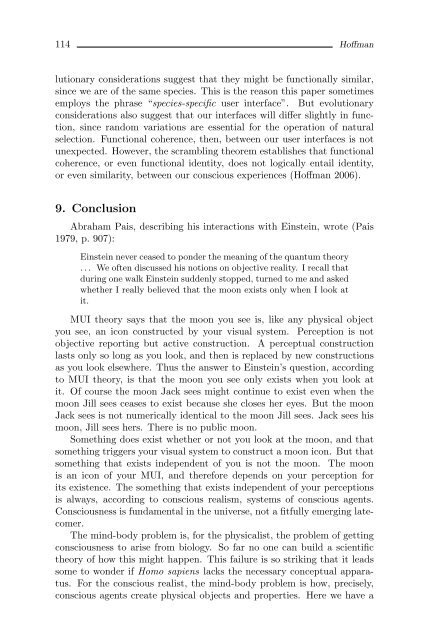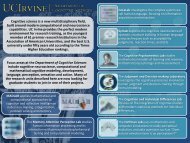Conscious Realism and the Mind-Body Problem - UCI Cognitive ...
Conscious Realism and the Mind-Body Problem - UCI Cognitive ...
Conscious Realism and the Mind-Body Problem - UCI Cognitive ...
You also want an ePaper? Increase the reach of your titles
YUMPU automatically turns print PDFs into web optimized ePapers that Google loves.
114 Hoffmanlutionary considerations suggest that <strong>the</strong>y might be functionally similar,since we are of <strong>the</strong> same species. This is <strong>the</strong> reason this paper sometimesemploys <strong>the</strong> phrase “species-specific user interface”. But evolutionaryconsiderations also suggest that our interfaces will differ slightly in function,since r<strong>and</strong>om variations are essential for <strong>the</strong> operation of naturalselection. Functional coherence, <strong>the</strong>n, between our user interfaces is notunexpected. However, <strong>the</strong> scrambling <strong>the</strong>orem establishes that functionalcoherence, or even functional identity, does not logically entail identity,or even similarity, between our conscious experiences (Hoffman 2006).9. ConclusionAbraham Pais, describing his interactions with Einstein, wrote (Pais1979, p. 907):Einstein never ceased to ponder <strong>the</strong> meaning of <strong>the</strong> quantum <strong>the</strong>ory. . . We often discussed his notions on objective reality. I recall thatduring one walk Einstein suddenly stopped, turned to me <strong>and</strong> askedwhe<strong>the</strong>r I really believed that <strong>the</strong> moon exists only when I look atit.MUI <strong>the</strong>ory says that <strong>the</strong> moon you see is, like any physical objectyou see, an icon constructed by your visual system. Perception is notobjective reporting but active construction. A perceptual constructionlasts only so long as you look, <strong>and</strong> <strong>the</strong>n is replaced by new constructionsas you look elsewhere. Thus <strong>the</strong> answer to Einstein’s question, accordingto MUI <strong>the</strong>ory, is that <strong>the</strong> moon you see only exists when you look atit. Of course <strong>the</strong> moon Jack sees might continue to exist even when <strong>the</strong>moon Jill sees ceases to exist because she closes her eyes. But <strong>the</strong> moonJack sees is not numerically identical to <strong>the</strong> moon Jill sees. Jack sees hismoon, Jill sees hers. There is no public moon.Something does exist whe<strong>the</strong>r or not you look at <strong>the</strong> moon, <strong>and</strong> thatsomething triggers your visual system to construct a moon icon. But thatsomething that exists independent of you is not <strong>the</strong> moon. The moonis an icon of your MUI, <strong>and</strong> <strong>the</strong>refore depends on your perception forits existence. The something that exists independent of your perceptionsis always, according to conscious realism, systems of conscious agents.<strong>Conscious</strong>ness is fundamental in <strong>the</strong> universe, not a fitfully emerging latecomer.The mind-body problem is, for <strong>the</strong> physicalist, <strong>the</strong> problem of gettingconsciousness to arise from biology. So far no one can build a scientific<strong>the</strong>ory of how this might happen. This failure is so striking that it leadssome to wonder if Homo sapiens lacks <strong>the</strong> necessary conceptual apparatus.For <strong>the</strong> conscious realist, <strong>the</strong> mind-body problem is how, precisely,conscious agents create physical objects <strong>and</strong> properties. Here we have a







